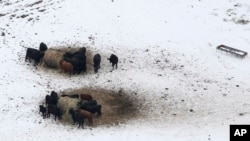U.S. regulators are asking drug companies to phase out the use of certain antibiotics intended to improve the growth of livestock.
Critics have long argued the practice is contributing to the worldwide antibiotic resistance crisis.
Large-scale livestock farms around the world often use small doses of antibiotics to help healthy animals grow faster with less feed.
Public health experts say that encourages bacteria to evolve defenses, making the drugs less effective to fight infections.
The new measure would end that practice over the next three years.
It would require a veterinarian to write a prescription for all other uses.
“With these changes, there will be fewer approved uses, and the remaining uses will be under tighter control to minimize the impact on resistance,” says FDA Deputy Commissioner Michael Taylor.
Voluntary program
The changes are voluntary, which has some angered some of FDA’s critics.
Advocates have been pressing the agency for years to end the use of antibiotics as growth promoters.
But Taylor says this approach is faster than going through the lengthy and complicated regulatory process.
And FDA can still make the change mandatory if companies do not go along voluntarily, Taylor adds.
Physician Dimitri Drekonja with the medical association the Infectious Diseases Society of America says FDA’s action is a good first step.
“If this voluntary effort is taken up by the entire industry and everybody goes along with it, then it will actually be a needed first and potentially last step,” he added. “Now, will that happen? I have my doubts.”
Making changes
Some major drug companies have already agreed to make the changes, however.
National Pork Producers Council Chief Veterinarian Liz Wagstrom says her industry is preparing to adjust.
“We may lose some efficiency,” Wagstrom says. “We may have some animals that may not grow quite as quickly or take more grain to reach their full weight.”
And they may see some more sick animals with the decline in antibiotic use, she says.
But she declined to put a price tag on the changes.
Measuring impact difficult
How the new policy affects the drug resistance problem may actually be hard to measure.
“It would be great if there was sort-of like a dashboard and you could watch the needle drop in the amount of antibiotics used and then watch the next gauge, which is the national resistance and see what happening there,” Drekonja says. “We don’t have two simple gauges like that.”
There is a real lack of good data on the amounts of antibiotics used on farms, as well as by doctors, he notes.
And others point out that some bacteria have remained resistant for years after certain antibiotics have been banned from animal use.
But with officials warning about an approaching post-antibiotic era, doctors say they have been taking steps to limit their use of these important drugs, and they say the livestock industry should, too.
Critics have long argued the practice is contributing to the worldwide antibiotic resistance crisis.
Large-scale livestock farms around the world often use small doses of antibiotics to help healthy animals grow faster with less feed.
Public health experts say that encourages bacteria to evolve defenses, making the drugs less effective to fight infections.
The new measure would end that practice over the next three years.
It would require a veterinarian to write a prescription for all other uses.
“With these changes, there will be fewer approved uses, and the remaining uses will be under tighter control to minimize the impact on resistance,” says FDA Deputy Commissioner Michael Taylor.
Voluntary program
The changes are voluntary, which has some angered some of FDA’s critics.
Advocates have been pressing the agency for years to end the use of antibiotics as growth promoters.
But Taylor says this approach is faster than going through the lengthy and complicated regulatory process.
And FDA can still make the change mandatory if companies do not go along voluntarily, Taylor adds.
Physician Dimitri Drekonja with the medical association the Infectious Diseases Society of America says FDA’s action is a good first step.
“If this voluntary effort is taken up by the entire industry and everybody goes along with it, then it will actually be a needed first and potentially last step,” he added. “Now, will that happen? I have my doubts.”
Making changes
Some major drug companies have already agreed to make the changes, however.
National Pork Producers Council Chief Veterinarian Liz Wagstrom says her industry is preparing to adjust.
“We may lose some efficiency,” Wagstrom says. “We may have some animals that may not grow quite as quickly or take more grain to reach their full weight.”
And they may see some more sick animals with the decline in antibiotic use, she says.
But she declined to put a price tag on the changes.
Measuring impact difficult
How the new policy affects the drug resistance problem may actually be hard to measure.
“It would be great if there was sort-of like a dashboard and you could watch the needle drop in the amount of antibiotics used and then watch the next gauge, which is the national resistance and see what happening there,” Drekonja says. “We don’t have two simple gauges like that.”
There is a real lack of good data on the amounts of antibiotics used on farms, as well as by doctors, he notes.
And others point out that some bacteria have remained resistant for years after certain antibiotics have been banned from animal use.
But with officials warning about an approaching post-antibiotic era, doctors say they have been taking steps to limit their use of these important drugs, and they say the livestock industry should, too.







